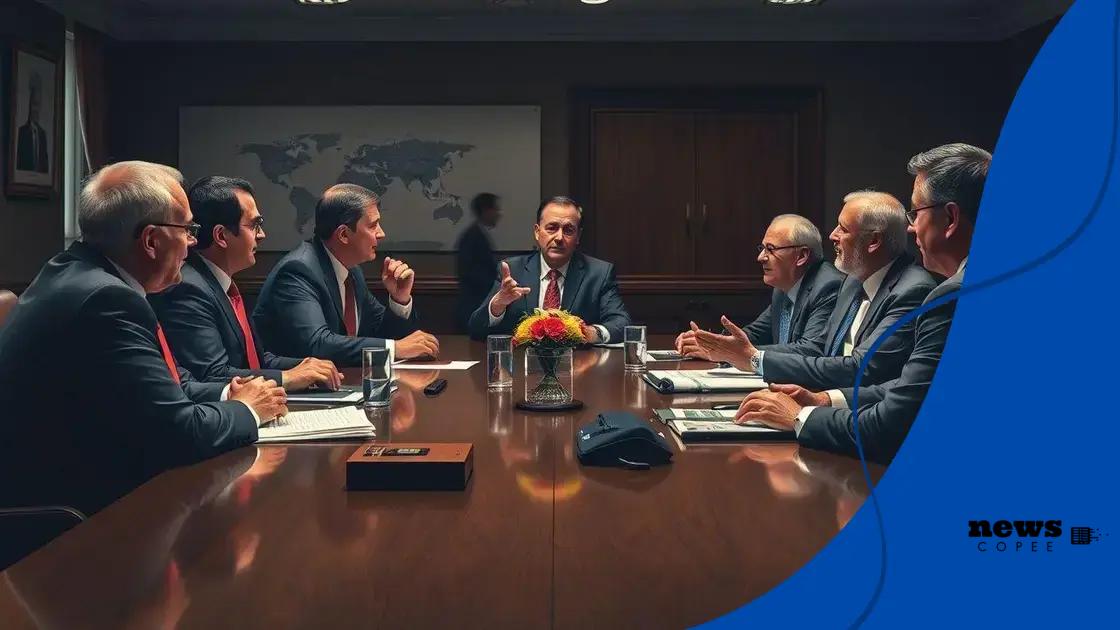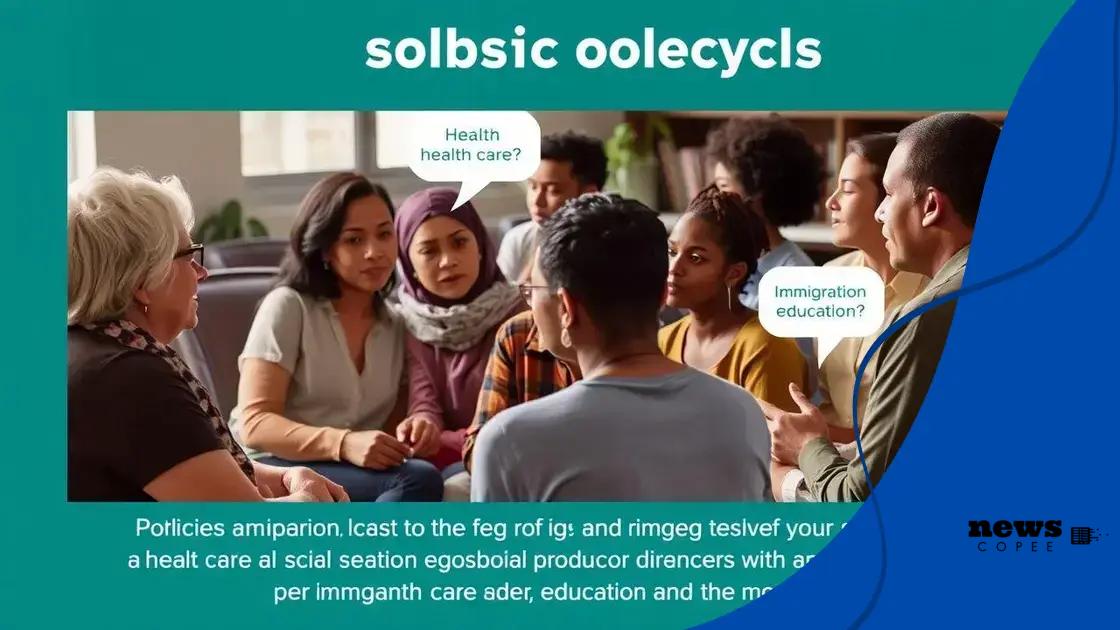Trump-era policies continue to evolve: what’s next?

Trump-era policies continue to evolve, influencing social, economic, and political landscapes in the U.S., as public perception and engagement shape future directions and decisions in governance.
Trump-era policies continue to evolve, transforming the political stage as we know it. Have you noticed how these shifts affect our daily lives? Let’s dive into what’s happening and what it means for the future.
Current impacts of Trump-era policies
The current impacts of Trump-era policies are evident across various aspects of American life. From the economy to social issues, the decisions made during that time continue to shape policy discussions today. Let’s explore how these policies are influencing us now.
Economic impacts
One of the most significant areas affected is the economy. Changes in trade agreements and tax laws are still playing a role. For example, the tax cuts implemented during Trump’s presidency aimed to spur growth but also raised concerns about the national deficit.
- Tax cuts benefitting corporations
- Increased focus on protectionism
- Changes in tariffs affecting costs
As the country moves forward, these economic policies create ongoing debates on their effectiveness and sustainability.
Social policy outcomes
Another key area is social policies. Decisions regarding health care, immigration, and education have far-reaching effects. For instance, changes in immigration policies have led to a reevaluation of border security and its implications for American communities.
Many citizens find themselves questioning how these policies align with the country’s values. Social justice movements are gaining momentum in response to these areas, showcasing public concern and demand for change.
As we examine these shifts, it’s important to consider what they mean for us in the present. The lasting effects of the Trump era continue to evoke strong feelings across the political spectrum.
Public perception
How do people perceive these policies today? Surveys reveal a mixed response, with some supporting the hardline approaches and others advocating for reform. This division reflects broader societal debates and highlights the ongoing influence of past decisions.
- Support for policies among conservative groups
- Calls for reform from liberal constituents
- Impact of social media in shaping opinions
The intersection of these views contributes significantly to the current political discourse, making it a critical factor in upcoming elections.
Economic changes under recent administrations
The economic changes under recent administrations have had a significant effect on the American economy. From tax reforms to trade policies, each decision has influenced various sectors in unique ways. Let’s delve into how these changes have shaped our current economic landscape.
Tax reforms and implications
Recent tax reforms have aimed at stimulating growth, yet they also sparked debates about fairness. For example, the cuts introduced have primarily benefited corporations. This has raised questions about income inequality and the distribution of wealth.
- Corporate tax cuts boosting profits
- Impact on middle-class taxpayers
- Concerns over budget deficits
Some argue that while these changes support economic expansion, they may lead to long-term challenges for funding social programs.
Trade policies and global relationships
Trade policies have also evolved, reflecting a shift towards more protectionist measures. This strategy aims to support American manufacturers but has come with its own set of complications. Increased tariffs on imports have raised prices for consumers, impacting daily expenses.
Moreover, conflicts with trading partners have led to uncertainty in markets. Businesses are left navigating this complex environment, often affecting their investment decisions. As the stakes rise, the global economy continues to feel the repercussions of American trade decisions.
Job market dynamics
The job market has seen fluctuations as a response to these economic policies. As industries adapt to the changing landscape, job creation becomes a pressing issue. The focus has shifted to sustainable employment growth, aiming to create opportunities for all.
- Growing sectors in technology and green energy
- Challenges for traditional manufacturing jobs
- Increased emphasis on skilled labor
These trends illustrate the need for a workforce that can adapt to new industries, ensuring economic stability and growth.
Social policies evolving from the Trump era

The social policies evolving from the Trump era have sparked a wide range of reactions across the United States. From health care to immigration, these changes have made a significant impact on people’s lives and communities.
Health care reforms
Health care has been a prominent area of focus. Efforts to repeal the Affordable Care Act have shifted attention to alternative solutions. Some proposals aim to provide more flexibility, while others raise concerns about access to care.
- Potential changes in insurance coverage
- Impact on pre-existing condition protections
- Community health resources facing challenges
As discussions continue, the balance between affordability and quality of care remains a top priority.
Immigration policy changes
Immigration policies have also undergone significant evolution. Restrictions implemented during the Trump administration led to intense debates about border security and humanitarian issues. These discussions have prompted a re-examination of how immigrants are treated and the resources available to them.
Many advocates argue for more humane policies that respect individual rights. At the same time, some communities feel the impact of stricter regulations firsthand, leading to divided opinions on the subject.
Education and social equity
Education policies reflect another layer of this evolution. Focus on school choice and voucher systems has gained traction, with supporters claiming it increases opportunities. However, this approach has faced criticism regarding its impact on public education funding.
- Debates over funding allocation
- Accessibility concerns for disadvantaged communities
- Trends in charter school growth
The push for equitable education continues to shape policy discussions, calling for solutions that address the needs of all students.
Key figures influencing policy shifts
Several key figures influencing policy shifts have emerged in recent years, shaping the direction of politics and social issues. Their actions and decisions have left a mark on various policies, drawing both support and criticism from different sectors of society.
Political leaders and their roles
Political leaders play a crucial role in crafting and implementing policies. Many recent administrations have introduced changes that reflect their individual ideologies. These leaders often champion specific reforms to address pressing issues such as healthcare and immigration, influencing public opinion along the way.
- The impact of executive orders
- Legislative priorities set by party leaders
- The role of grassroots movements
As these leaders propose new ideas, the reactions from lawmakers and citizens are diverse, showcasing the complexity of modern governance.
Influence from advocacy groups
Advocacy groups have significantly contributed to policy developments. These organizations work tirelessly to represent the interests of various communities, often putting pressure on lawmakers to take action. Their efforts can lead to changes in legislation that align with public needs.
Many advocate for social causes like climate change, education reform, and healthcare access. Their influence not only raises awareness but also mobilizes voters, impacting elections and policy priorities.
Media’s role in shaping narratives
The media also plays a vital role in shaping the perception of policies and the figures behind them. Through coverage and analysis, the media highlights key issues and brings them to the forefront of public discourse. This attention can amplify the voices of influential leaders and advocacy groups, affecting how policies are perceived by the public.
- Coverage of political events and speeches
- Investigative journalism highlighting issues
- Social media campaigns influencing public opinion
With the ability to reach broad audiences, media outlets help determine the narratives that surround policy changes, illustrating the interconnectedness of communication and politics.
Public perception and response to policies
The public perception and response to policies have undergone significant changes in recent years. As policies are proposed and implemented, the reactions from citizens vary widely, often driven by media coverage and personal experiences.
Influence of social media
Social media platforms have become a crucial space for people to express their views. With just a few clicks, individuals can share their opinions, creating viral moments that influence broader public sentiment. These platforms allow for quick dissemination of information, shaping how policies are viewed.
- Real-time reactions to policy announcements
- Influential social media campaigns
- Direct engagement between politicians and constituents
Moreover, the ability to connect directly with leaders can enhance accountability and drive more people to participate in discussions about important issues.
Polls and surveys
Polls and surveys are traditional methods used to gauge public opinion. Organizations regularly collect data to understand how different demographics view policies. These insights help shape future decisions and political strategies.
For instance, data indicating strong support for environmental policies can prompt lawmakers to prioritize climate initiatives. Conversely, negative feedback may lead to policy reevaluation.
Grassroots movements
Grassroots movements often emerge in response to specific policies or societal issues. These movements unite individuals around common goals, such as advocating for social justice, environmental protection, or healthcare reform.
- Mobilization for local and national causes
- Public demonstrations and events
- Coalition-building among diverse groups
By focusing on community engagement, grassroots efforts can significantly influence public perception and lead to policy changes, showcasing the power of collective action.
The discussions surrounding Trump-era policies showcase the ongoing evolution of social, economic, and political landscapes in the United States. Public perceptions continually shape and reshape as communities engage with these policies. As individuals voice their opinions, whether through social media or grassroots movements, their collective efforts can drive significant changes. Understanding these dynamics is crucial for navigating today’s complex environment. By actively participating in discussions and advocating for their beliefs, citizens play a vital role in influencing future policies and creating a better society.
\n\n\n
\n
\n
FAQ – Questions about the evolution of Trump-era policies
What are Trump-era policies?
Trump-era policies refer to the political, economic, and social changes implemented during Donald Trump’s presidency from 2017 to 2021.
How do these policies impact everyday life?
These policies can affect various aspects of life, including healthcare access, immigration, and economic conditions, shaping people’s daily experiences.
What role does public perception play in policy changes?
Public perception can significantly influence policy changes as lawmakers respond to the opinions and demands of their constituents.
How has social media affected discussions on these policies?
Social media allows for real-time discussions and activism, amplifying voices and opinions, and often driving public engagement on important issues.
